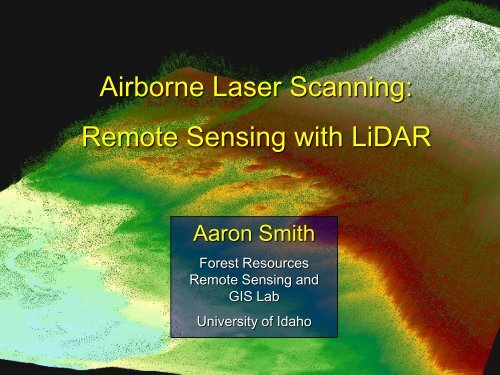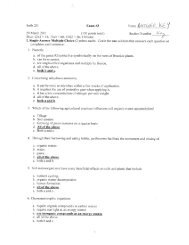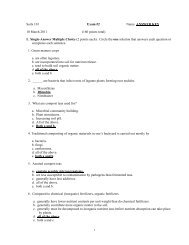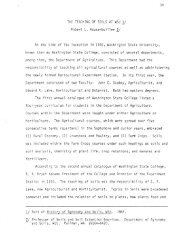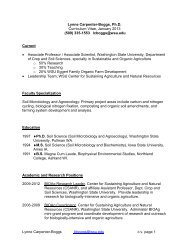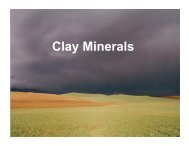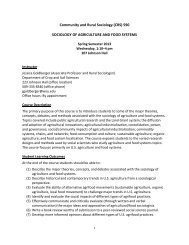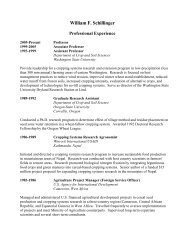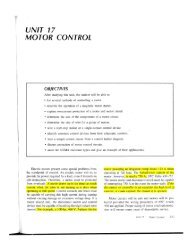Airborne Laser Scanning: Remote Sensing with LiDAR
Airborne Laser Scanning: Remote Sensing with LiDAR
Airborne Laser Scanning: Remote Sensing with LiDAR
You also want an ePaper? Increase the reach of your titles
YUMPU automatically turns print PDFs into web optimized ePapers that Google loves.
<strong>Airborne</strong> <strong>Laser</strong> <strong>Scanning</strong>:<br />
<strong>Remote</strong> <strong>Sensing</strong> <strong>with</strong> <strong>LiDAR</strong><br />
Aaron Smith<br />
Forest Resources<br />
<strong>Remote</strong> <strong>Sensing</strong> and<br />
GIS Lab<br />
University of Idaho
• <strong>Laser</strong> remote sensing background<br />
• Basic components of an ALS/LIDAR system<br />
• Two distinct families of ALS systems<br />
• Waveform<br />
ALS / <strong>LiDAR</strong> outline<br />
• Discrete Return (small footprint)<br />
• Working <strong>with</strong> the data, processing requirements<br />
• Current applications and developing applications<br />
• Advancing ALS / <strong>LiDAR</strong> technology
<strong>Airborne</strong> <strong>Laser</strong> <strong>Scanning</strong><br />
• ALS/<strong>LiDAR</strong> is an active remote<br />
sensing technology that<br />
measures distance <strong>with</strong> reflected<br />
laser light<br />
• 1 st developed in 1960 by<br />
Hughes Aircraft inc.<br />
• Modern computers and DGPS<br />
make it practical<br />
• Typically used in very accurate<br />
mapping of topography<br />
• New technologies and<br />
applications are currently being<br />
developed
Why use a <strong>Laser</strong>?<br />
ALS systems take advantage of two of the unique properties of<br />
laser light:<br />
1. The laser is monochromatic. It is one specific wavelength of<br />
light. The wavelength of light is determined by the lasing material<br />
used.<br />
Advantage: We know how specific wavelengths interact <strong>with</strong> the<br />
atmosphere and <strong>with</strong> materials.<br />
2. The light is very directional. A laser has a very narrow beam<br />
which remains concentrated over long distances. A flashlight (or<br />
Radar) on the other hand, releases energy in many directions,<br />
and the energy is weakened by diffusion.<br />
Advantage: The beam maintains its strength over long distances.<br />
3mrad divergence = 30 cm at 1 km and 1.5m at 5 km<br />
For an easy to understand discussion of how lasers work check out:<br />
http://www.howstuffworks.com/laser.htm
ALS mapping concepts<br />
• The position of the aircraft is known<br />
(from DGPS and IMU)<br />
• Measures distance to surfaces by<br />
timing the outgoing laser pulse and<br />
the corresponding return(s)<br />
• Distance = time*(speed of light)/2<br />
• By keeping track of the angle at<br />
which the laser was fired: you can<br />
calculate the X, Y, Z position of each<br />
“return”<br />
• Requires extremely accurate timing<br />
and a very fast computer
Basic ALS System Components<br />
• <strong>Laser</strong> (usually NIR –1064nm)<br />
mounted in an aircraft<br />
• <strong>Scanning</strong> assembly – precisely<br />
controlled rotating mirror<br />
• Receiver for recording reflected<br />
energy “Returns”<br />
• Aircraft location system<br />
incorporating Differential<br />
GPS and Inertial<br />
Navigation System<br />
• A very fast computer to<br />
synchronize and control<br />
the whole thing
Two distinct families of ALS systems<br />
Waveform systems (a.k.a. large-footprint)<br />
Records the COMPLETE range of the energy pulse (intensity)<br />
reflected by surfaces in the vertical dimension<br />
Samples transects in the horizontal (X,Y) plane<br />
Waveform systems designed to capture vegetation information are<br />
not widely available<br />
Waveform systems include SHOALS, SLICER, LVIS, ICESat<br />
Discrete-return systems (a.k.a. small-footprint or topographic)<br />
SAMPLES the returned energy from each outgoing laser pulse in<br />
the vertical plane (Z) (if the return reflection is strong enough)<br />
Most commercial lidar systems are discrete return, many different<br />
types are available
Waveform <strong>LiDAR</strong><br />
This is the “waveform” graph of energy intensity<br />
Notice that it follows the “shape” of the tree biomass
Waveform <strong>LiDAR</strong>: SLICER<br />
Waveform systems have been used to accurately measure<br />
(r 2 >.90) vertical distribution of tropical and temperate forests<br />
(Lefsky 2001)
Spaceborne <strong>LiDAR</strong>: ICEsat and VCL<br />
Spaceborne waveform<br />
<strong>LiDAR</strong> systems<br />
ICEsat launched in 2003 for<br />
survey of topography and<br />
polar ice<br />
VCL Launch date???<br />
(pending funding)<br />
VCL Designed to sample 5<br />
separate widely spaced<br />
tracks <strong>with</strong> 25m footprint<br />
waveforms<br />
Do not provide “wall to wall”<br />
mapping
Discrete-return <strong>LiDAR</strong><br />
• Records data as X,Y,Z points<br />
• Spatial resolution is expressed<br />
in terms of “post spacing” which<br />
is the avg. horizontal distance<br />
between points<br />
• Returns are “triggered” if the<br />
laser reflects from a surface large<br />
enough to exceed a pre-set<br />
energy threshold<br />
• Minimum vertical distance<br />
between returns is ~ 5 meters<br />
• New capability to record the<br />
intensity of point returns.
Discrete return data: Millions of X,Y,Z points<br />
Area is approximately: 1 X 0.75mi.<br />
includes ~ 440,000 returns
From point clouds to 3-D surface models<br />
• Points are used to create 3D<br />
surface models for applications<br />
• Triangular Irregular Networks<br />
(TIN)s are used to classify the<br />
points and to develop Digital<br />
Elevation Models (DEM)s<br />
• Points must be classified<br />
before use: “bare earth” points<br />
hit the “ground”; other point<br />
categories include tree canopy<br />
and buildings<br />
• Correct identification of “bare<br />
earth” is critical for any lidar<br />
mapping application
<strong>LiDAR</strong> surfacing
Working <strong>with</strong> Commercial <strong>LiDAR</strong><br />
Discrete return lidar data requires several complex processing<br />
steps to develop useable products, these steps are usually<br />
divided into two phases:<br />
Pre-processing is the preparation of the raw data, correcting for<br />
errors induced by flight geometry, removing overlaps<br />
between flight lines, surfacing, and accuracy assessment of<br />
the raw point locations<br />
Post-processing is the development of usable information from<br />
the point clouds including development of TINs, DEMs, and<br />
other products like canopy height maps<br />
Pre-processing is always done by the lidar contractor
Discrete Return <strong>LiDAR</strong> Accuracy<br />
• Average reported point location accuracies for a hard flat<br />
reflective surface (e.g. airport runway):<br />
2-15 cm vertical<br />
25-100 cm horizontal<br />
• Reported measurement accuracies: (forestry research, best cases)<br />
Height prediction r 2 = 0.93 (Means 2000)<br />
Volume prediction r 2 = 0.92 (Maclean and Krabill 1992)<br />
Comparing field measurements to laser measurements<br />
• Timing system accuracy is critical: 1 nanosecond = 30cm<br />
• Accuracy is also affected by errors in GPS, surfacing and data<br />
analysis<br />
• Measurements of object height requires accurate surfacing to<br />
provide accurate base height
Applications for Discrete-Return <strong>LiDAR</strong><br />
Digital Elevation Model (DEM)<br />
4m DEM of PREF Subset
Geomorphology<br />
Mapping geomorphic features (Puget Sound <strong>LiDAR</strong> Consortium)
Geology<br />
Mapping Faults (Puget Sound <strong>LiDAR</strong> Consortium)
Other Applications<br />
Measuring volume change<br />
in open pit mines<br />
Utilities use lidar to map<br />
power transmission line<br />
curvature and clearance
Discrete Return <strong>LiDAR</strong> for Forestry<br />
Can be used to measure<br />
forest characteristics<br />
including stand height,<br />
biomass distribution,<br />
volume.<br />
DEMs are used in<br />
planning for erosion and<br />
engineering projects<br />
including roads<br />
Mapping of forest stand<br />
structure characteristics<br />
and fire fuels conditions is<br />
under development
Forest Engineering
<strong>LiDAR</strong> mapping of forest structure
<strong>LiDAR</strong> captures 3D structure information
<strong>LiDAR</strong> products for forest management
Working <strong>with</strong> <strong>LiDAR</strong><br />
If you want to use commercial ALS data for a specific application:<br />
• Educate yourself prior to seeking a contractor<br />
• Clearly communicate early and often through out the<br />
acquisition process, be specific about deliverables<br />
• Get involved in the flight planning process, stay involved<br />
through accuracy assessment, QC, and post processing<br />
• Most forestry applications for discrete return lidar (other<br />
than developing contours/DEMs) are relatively new and<br />
untested: rigorous quantitative accuracy assessment needs<br />
to be done on any “product”<br />
• If you plan to do post-processing “in house” realize that it is<br />
an intensive and complex process requiring substantial<br />
GIS/<strong>Remote</strong> sensing expertise and computer support
The future of ALS<br />
ALS/<strong>LiDAR</strong> technology is evolving rapidly, the next 10<br />
years will bring many new capabilities and applications<br />
• The PREF data we are working <strong>with</strong> (slide 12) was flown at<br />
15,000 pulses per second. Systems are now available that<br />
record 50,000 pps. Expect to see 100,000 pps systems<br />
soon<br />
• Automatic merging of multi-spectral imagery <strong>with</strong> <strong>LiDAR</strong> is<br />
being developed now<br />
• <strong>Laser</strong> induced fluorescence and measurement of changes in<br />
laser coherence and polarization will provide more<br />
information about the surfaces that the laser light interacts<br />
<strong>with</strong><br />
• Look for multi-spectral <strong>LiDAR</strong> using multiple lasers in different<br />
frequencies recording intensity to spectrally identify<br />
surface materials
New ALS technologies<br />
This is an example of a new application that merges lidar and<br />
multi-spectral imagery to automatically classify features<br />
• Expect higher data density: current systems operate at 15,000hz;<br />
• New systems operate at 50,000hz,<br />
• Next generation will be 100,000hz +
Gamba and Houshmand 1999
Concepts to remember about ALS<br />
1. ALS/<strong>LiDAR</strong> is an active remote sensing technology designed<br />
to take advantage of the unique properties of laser light<br />
2. Two basic families of lidar systems exist: waveform and<br />
discrete-return<br />
3. Commercially available lidar is discrete-return, it is used in for<br />
a number of applications<br />
4. Accuracy of ALS is dependant on a number of highly complex<br />
interacting factors<br />
5. Complex processing steps are required to use lidar and<br />
accurate surfacing is critical for applications measuring object<br />
heights<br />
6. Development of lidar technology is occurring at a rapid pace,<br />
new applications will develop
Case study on use of small-<br />
footprint lidar for generating<br />
crown structure<br />
• Akira Kato, PhD candidate, UW<br />
• L.Monika Moskal (UW)<br />
• Werner Stuetzle (UW)<br />
• Mark E. Swanson (WSU)<br />
• Peter Schiess (UW)<br />
• Donna Calhoun (UW)
Surface wrapping using spatial<br />
interpolation methods (Kato et al. 2007)<br />
Point cloud Wrapped surface
Ground truthing tree<br />
crown parameters<br />
• Nikon total station set up 4-5 tree heights<br />
from tree<br />
• Measured precisely:<br />
– Distance to tree<br />
– Angles to base of crown, top of tree<br />
– Horizontal angles to crown edge every 5º vertical
LIDAR VS. FIELD<br />
Slide: Akira Kato<br />
(Google map)<br />
Conical shape case<br />
Giant Sequoia<br />
(Sequoiadendron giganteum)
VALIDATION<br />
The total station (Nikon DTM -450)<br />
SE<br />
E W<br />
NE<br />
N<br />
S<br />
NW<br />
SW<br />
Slide: Akira Kato
CROWN VOLUME<br />
Parameters Traditional<br />
The Total Station<br />
8 profiles ISR<br />
CV (m 3 ) 2422 2825 2894<br />
RE (%) 19 2 NA<br />
Slide: Akira Katoc<br />
LID A R data C one<br />
Integration of<br />
the crow n profiles W rapped surface
LIDAR VS. FIELD<br />
Round shape case<br />
Cedarwood Atlas<br />
(Cedrus atlantica)
CROWN VOLUME<br />
Parameters<br />
The Total Station<br />
8 profiles ISR<br />
CV (m 3 Method<br />
) 4534 4780<br />
RE (%) 0.05 NA<br />
Slide: Akira Kato
GROUND VS. AIRBORNE LIDAR<br />
knobcone pine (Pinus attenuata)<br />
Slide: Akira Kato<br />
Airbone <strong>LiDAR</strong> *Ground-based <strong>LiDAR</strong> Red: airborne<br />
Blue: Ground-based<br />
<strong>Airborne</strong> <strong>LiDAR</strong> is captured at March 2005 and ground-based <strong>LiDAR</strong> is captured<br />
at Sept. 2007. The seasonality does not matter (because it is coniferous), but<br />
there are two years difference.<br />
*Ground-based <strong>LiDAR</strong> data was captured from two vantage points separated around<br />
180 degrees each other in terms of the stem. So it covers all aspects of a single tree.
GROUND VS. AIRBORNE LIDAR<br />
Slide: Akira Kato<br />
Crown Volume:<br />
859.49 m 3<br />
Crown Volume:<br />
1058.15 m 3<br />
Crown volume estimated by the total station is 1029.76 m 3 , which is close to<br />
the crown volume estimated by the ground-based <strong>LiDAR</strong> through the wrapped surface.


